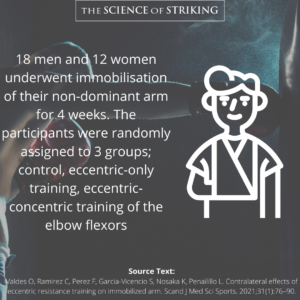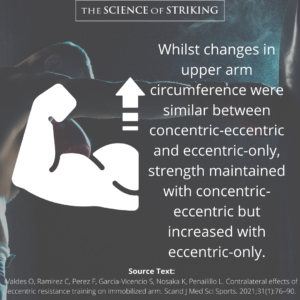I am a big fan of the cross education effect, and use it often in the rehabilitation setting.
Past research has shown that resistance training on one limb may enhance strength levels on the other, and that when the other limb is immobilized (which would usually lead to a decrease in strength and muscle mass), strength and size is maintained.
This study sought to investigate the differences in the cross education effect between eccentric-only training and eccentric-concentric training.
18 men and 12 women underwent immobilisation of their non-dominant arm for 4 weeks. The participants were randomly assigned to 3 groups; control, eccentric-only, eccentric-concentric. Dependent variables were: upper arm circumference, concentric 1RM elbow flexion. Maximal voluntary contraction (MVIC), elbow flexor surface EMG, rate of force development and elbow flexion joint position sense.
The training program progressed from 4 sets of 10 in week 1 to 6 sets in week 4 in the eccentric-concentric group (CON-ECC), and 3 sets of 10 in week 1 to 4 sets in week 4 for the eccentric group (ECC). The intensity progressed from 60% to 90% of concentric 1RM in CON-ECC and from 80% to 120% in ECC. Whilst the study was set up to be volume-matched, the volume was slightly higher in ECC (5,616 vs. 5,342).
Both CON-ECC and ECC showed similar decreases in arm circumference (2.1%) compared to 5.1% in the control group. For 1RM strength, the control group showed a 14.1% decrease, compared to no change in CON-ECC and a trend (3.4%) towards an increase in ECC. MVIC decreased by 21.7% in the control group, was unchanged in CON-ECC, and increased by 12.7% in ECC.
The authors hypothesise these superior outcomes from eccentric-only training to be related to greater descending neural drive, corticospinal excitability, and increases in antagonist muscle inhibition, related to the greater intensity of eccentric training.
The advantage of cross education is fairly well established in modern rehabilitation, however this latest study proposes a potential role for eccentric training in optimising this effect.


